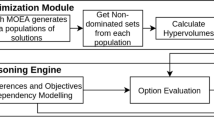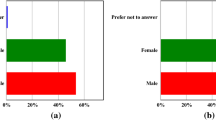Abstract
Ride-sharing systems should combine environmental protection (through a reduction of fossil fuel usage), socialization, and security. Encouraging people to use ride-sharing systems by satisfying their demands for safety, privacy and convenience is challenging. Most previous works on this topic have focused on finding a fixed path between the driver and the riders either based solely on their locations or using social information. The drivers’ and riders’ lack of options to change or compute the path according to their own preferences and requirements is problematic. With the advancement of mobile social networking technologies, it is necessary to reconsider the principles and desired characteristics of ride-sharing systems. In this paper, we formalized the ride-sharing problem as a multi source-destination path planning problem. An objective function that models different objectives in a unified framework was developed. Moreover, we provide a similarity model, which can reflect the personal preferences of the rides and utilize social media to obtain the current interests of the riders and drivers. The model also allows each driver to generate sub-optimal paths according to his own requirements by suitably adjusting the weights. Two case studies have shown that our system has the potential to find the best possible match and computes the multiple optimal paths against different user-defined objective functions.
Similar content being viewed by others
References
http://environment.about.com/od/globalwarming/tp/globalwarmtips.html
Kwon J, Varaiya P. Effectiveness of California’s High Occupancy Vehicle (HOV) system. Transportation Research Part C: Emerging Technologies, 2010, 16(1): 98–115
Jeanes P. Can total car emissions be reduced enough by 2020? Traffic Engineering & Control, 2010, 51(1): 6–8
Agatz N, Erera A, Savelsbergh M, Wang X. Sustainable passenger transportation: dynamic ride-sharing. Technical report, Erasmus Research Institute of Management (ERIM), 2010
Yousaf J, Li J, Chen L, Tang J, Dai X, Du J. Ride-sharing: a multi source-destination path planning approach. Lecture Notes in Computer Science, 2012, 7691: 815–826
Gilbert E, Karahalios K. Predicting tie strength with social media. In: Proceedings of the SIGCHI Conference on Human Factors in Computing Systems. 2009, 211–220
Trasarti R, Pinelli F, Nanni M, Giannotti F. Mining mobility user profiles for car pooling. In: Proceedings of the 17th ACM SIGKDD international conference on Knowledge discovery and data mining. 2011, 1190–1198
Kleiner A, Nebel B, Ziparo V A. A mechanism for dynamic ride shar ing based on parallel auctions. In: Proceedings of the 22nd International Joint Conference on Artificial Intelligence. 2011, 1: 266–272
Li X, Pan G, Wu Z, Qi G, Li S, Zhang D, Zhang W, Wang Z. Prediction of urban human mobility using large-scale taxi traces and its applications. Frontiers of Computer Science, 2012, 6(1): 111–121
Chen C, Zhang D, Castro P S, Li N, Sun L, Li S. Real-time detection of anomalous taxi trajectories from GPS traces. Lecture Notes in Computer Science, 2012, 104: 63–74
Resnick P. Sociotechnical support for ride sharing. Technical report, School of information, University of Michigan, 2006
Kelley K L. Casual carpooling-enhanced. Journal of Public Transportation, 2007, 10(4): 119–130
Murphy P. The smart jitney: rapid, realistic transport. New Solutions Journal, 2007, (12): 1–12
Gidófalvi G, Herenyi G, Bach Pedersen T. Instant social ride-sharing. In: Proceedings of the 15th World Congress on Intelligent Transport Systems. 2008, 1–8
Morris J. Saferide: Reducing single occupancy vehicles. Technical report, Technical report, 2008
Kirshner D. Ride now. http://www.ridenow.org, 2009
Vanoutrive T, Van De Vijver E, Van Malderen L, Jourquin B, Thomas I, Verhetsel A, Witlox F. What determines carpooling to workplaces in Belgium: location, organisation, or promotion? Journal of Transport Geography, 2012, 22: 77–86
Chan N D, Shaheen S A. Ridesharing in North America: past, present, and future. Transport Reviews, 2012, 32(1): 93–112
Herbawi W, Weber M. Evolutionary multiobjective route planning in dynamic multi-hop ridesharing. Lecture Notes in Computer Science, 2011, 6622: 84–95
Martins E d Q V, Santos J. The labeling algorithm for the multiobjective shortest path problem. Technical report, Departamento de Matematica, Universidade de Coimbra, Portugal, TR-99/005, 1999
Müller-Hannemann M, Weihe K. Pareto shortest paths is often feasible in practice. Lecture Notes in Computer Science, 2001, 2141: 185–197
Shad R, Ebadi H, Ghods M. Evaluation of route finding methods in GIS application. In: Proceedings of Map Asia 2003. 2003, 12–20
Mooney P, Winstanley A. An evolutionary algorithm for multicriteria path optimization problems. International Journal of Geographical Information Science, 2006, 20(4): 401–423
Pangilinan J M A, Janssens G. Evolutionary algorithms for the multiobjective shortest path problem. International Journal of Applied Science, Engineering and Technology, 2007, 4(1): 206–210
Sankaranarayanan J, Samet H, Teitler B E, Lieberman M D, Jon S. Twitterstand: news in tweets. In: Proceedings of the 17th ACM SIGSPATIAL International Conference on Advances in Geographic Information Systems. 2009, 42–51
Shamma D A, Kennedy L, Churchill E F. Tweet the debates: understanding community annotation of uncollected sources. In: Proceedings of the 1st SIGMM workshop on Social media. 2009, 3–10
Leskovec J, Kleinberg J, Faloutsos C. Graph evolution: Densification and shrinking diameters. ACM Transactions on Knowledge Discovery from Data, 2007, 1(1)
Kristina L, Rumi G. Information contagion: an empirical study of spread of news on digg and twitter social networks. In: Proceedings of the 4th International Conference on Weblogs and Social Media. 2010, 90–97
Lerman K, Hogg T. Using a model of social dynamics to predict popularity of news. In: Proceedings of the 19th International Conference on World Wide Web. 2010, 621–630
Borau K, Ullrich C, Feng J, Shen R. Microblogging for language learning: Using twitter to train communicative and cultural competence. Lecture Notes in Computer Science, 2007, 5686: 78–87
Sakaki T, Okazaki M, Matsuo Y. Earthquake shakes twitter users: real-time event detection by social sensors. In: Proceedings of the 19th International Conference on World Wide Web. 2010, 851–860
Chaube V. Understanding and Designing for Perceptions of Trust in Rideshare Programs. PhD thesis, Virginia Polytechnic Institute and State University, 2010
Chaube V, Kavanaugh A L, Perez-Quinones M A. Leveraging social networks to embed trust in rideshare programs. In: Proceedings of the 43rd Hawaii International Conference on System Sciences. 2010, 1–8
Wessels R. Combining ridesharing & social networks. Technical report, 2009
North A C, Hargreaves D J, Hargreaves J J. Uses of music in everyday life. Music Perception, 2004, 22(1): 41–77
Rentfrow P J, Gosling S D. Message in a ballad the role of music preferences in interpersonal perception. Psychological Science, 2006, 17(3): 236–242
Knobloch S, Vorderer P, Zillmann D. The impact of music preferences on the perception of potential friends in adolescence. Zeitschrift Fur Sozialpsychologie, 2000, 31(1): 18–30
Lonsdale A J, North A C. Musical taste and ingroup favouritism. Group Processes & Intergroup Relations, 2009, 12(3): 319–327
Selfhout M H, Branje S J, Bogt t T F, Meeus W H. The role of music preferences in early adolescents’ friendship formation and stability. Journal of Adolescence, 2009, 32(1): 95–107
Boer D, Fischer R, Strack M, Bond M H, Lo E, Lam J. How shared preferences in music create bonds between people values as the missing link. Personality and Social Psychology Bulletin, 2011, 37(9): 1159–1171
Boyd D, Golder S, Gilad L. Tweet, tweet, retweet: Conversational aspects of retweeting on twitter. In: Proceedings of the 43rd Hawaii International Conference on System Sciences. 2010, 1–10
Leiserson C E, Rivest R L, Stein C, Cormen T H. Introduction to algorithms. The MIT Press, 2001
Vetter C. Fast and exact mobile navigation with openstreetmap data. Master’s Thesis, University of Karlsruhe, 2010
Author information
Authors and Affiliations
Corresponding author
Additional information
Jamal Yousaf is a PhD in Computer Science at the Department of Computer Science and Technology, Tsinghua University, China. He received his MS in Mathematics in 2000 from the Quaid-i-Azam University and Masters in Computer Engineering in 2005 from UET Taxila, Pakistan. He has 12 years of software development experience in research based public sector organization. His research interests are social network analysis & mining, knowledge engineering, and path planning.
Juanzi Li is a professor at Tsinghua University, and is the vice director of Chinese Information Processing Society of Chinese Computer Federation in China. Her research interests contain semantic Web, text and social network mining.
Lu Chen was a researcher at General Motors R&D. He received the BS and PhD in Computer Science from Zhejiang University in 2005 and 2011 respectively. His current research interests focus on the intelligent system used in vehicle.
Jie Tang is an associate professor at the Department of Computer Science and Technology, Tsinghua University. His research interests include social network analysis, data mining, and machine learning. He was honored with the CCF Young Scientist Award, NSFC Excellent Young Scholar, IBM Innovation Faculty Award, and the New Star of Beijing Science & Technology. He has published more than 100 journal/conference papers in major international journals and conferences. He is now leading the project Arnetminer.org for academic social network analysis and mining.
Xiaowen Dai is the Lab Group Manager of Connected Driving User Experience Group from GM China Science Lab. Before she takes on this responsibility, Dr. Dai is the Senior Manager of Advance Technology Management in GM China T&E dept, and Staff Researcher in Electric Control Integration Lab from GM R&D organization in Warren MI. Dr. Dai receivecl her PhD from Penn State University, and has published papers and patents.
Rights and permissions
About this article
Cite this article
Yousaf, J., Li, J., Chen, L. et al. Generalized multipath planning model for ride-sharing systems. Front. Comput. Sci. 8, 100–118 (2014). https://doi.org/10.1007/s11704-013-3021-6
Received:
Accepted:
Published:
Issue Date:
DOI: https://doi.org/10.1007/s11704-013-3021-6




